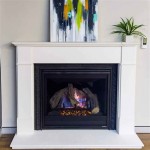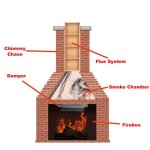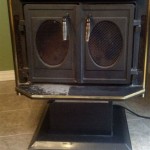Redoing Your Fireplace Surround: A Comprehensive Guide
The fireplace often serves as a focal point within a home. A well-maintained and aesthetically pleasing fireplace surround can significantly enhance the overall ambiance of a living space. Conversely, an outdated or damaged surround can detract from the room's appeal. Redoing a fireplace surround presents an opportunity to update the aesthetic, improve functionality, and potentially increase a home's value. This article provides a comprehensive overview of the process, encompassing planning, material selection, preparation, installation, and finishing.
Assessing the Existing Fireplace Surround
Before embarking on a renovation project, a thorough assessment of the existing fireplace surround is crucial. This assessment serves as the foundation for subsequent planning and decision-making. Key aspects to consider include:
First, an evaluation of its structural integrity is necessary. Examine the existing surround for any signs of damage, such as cracks, chips, or loose components. Determine the root cause of any observed damage. In some cases, superficial damage can be easily repaired, while more extensive damage might necessitate a complete replacement. Evaluate the stability of the underlying structure to which the surround is attached. This is particularly important if the existing surround is heavy, as the supporting structure must be capable of bearing the weight of the new surround. If significant structural issues are identified, consulting with a qualified structural engineer or contractor may be required.
Second, analyze the existing material of the surround. Identify the type of material used, whether it is brick, stone, wood, tile, or a combination thereof. Understanding the material composition can inform the selection of appropriate removal techniques and potential replacement materials. Certain materials, such as asbestos-containing materials, require specialized handling and disposal procedures. If there is any suspicion of hazardous materials, professional testing is essential before commencing any work.
Third, carefully measure the dimensions of the existing surround. Accurate measurements are critical for ensuring that the new surround fits properly and integrates seamlessly with the surrounding wall. Measure the height, width, and depth of the surround, as well as the dimensions of the firebox opening. Also, note the distance between the floor and the bottom of the firebox opening. Photographic documentation of the existing surround can also be helpful during the planning phase, particularly when comparing different design options or consulting with contractors.
Finally, consider conducting research into potential building codes and regulations which may dictate how fireplace surrounds must be constructed, fireproofed, and inspected. Contacting the local building inspection office can ensure the planned fireplace surround aligns with the most current regulations. A permit may be required to perform any upgrades to the fireplace area.
Material Selection: Balancing Aesthetics and Functionality
Selecting the appropriate materials for a fireplace surround involves striking a balance between aesthetic preferences and functional requirements. The choice of materials significantly impacts the overall appearance, durability, and maintenance requirements of the surround. Factors to consider include:
Consider brick as a durable and classic option. Brick is a traditional material often associated with fireplaces. It offers excellent heat resistance and can be easily customized to suit a variety of architectural styles. Brick surrounds can be painted, stained, or left natural, providing flexibility in terms of design. However, brick can be relatively heavy and may require additional structural support.
Stone provides a more luxurious appeal. Stone surrounds offer a natural and elegant look. Different types of stone, such as marble, granite, limestone, and slate, offer varying textures, colors, and patterns. Stone is highly durable and heat-resistant, but it can also be relatively expensive. Professional installation is often recommended for stone surrounds due to their weight and the precision required for proper installation.
Wood offers warmth and versatility. Wood surrounds provide a warm and inviting feel. Wood is relatively easy to work with and can be customized with a variety of finishes, such as paint, stain, or varnish. However, wood is not as heat-resistant as brick or stone and must be properly protected from the heat of the firebox. Building codes may dictate what type of woods can be used given their flammability ratings. It is a viable option for electric fireplace inserts.
Tile provides a wide range of design options. Tile surrounds offer a wide range of design possibilities, with an extensive selection of colors, sizes, and patterns available. Tile is relatively easy to clean and maintain, and it is also resistant to heat and moisture. Tile can be used to create intricate mosaics or simple, minimalist designs. When using tile near a fireplace, it is important to select tiles that are specifically designed for high-temperature applications.
Manufactured stone veneer offers an alternative to natural stone. Manufactured stone veneer is a lightweight alternative to natural stone. It is made from concrete and molded to resemble the look and texture of natural stone. Manufactured stone veneer is less expensive than natural stone and is easier to install. It is also relatively durable and heat-resistant. As with natural stone, professional installation is often recommended.
Budgetary constraints may have an impact on material selections. The cost of materials varies significantly depending on the type and quality of the material chosen. It is important to establish a budget early in the planning process and to select materials that align with that budget. Consider obtaining quotes from multiple suppliers to compare prices and ensure that the best possible value is obtained. Consider the long-term cost of ownership, including maintenance and potential repairs, when making material selections.
Installation: A Step-by-Step Guide
The installation process for a fireplace surround typically involves several key steps, from removing the old surround to installing the new one. The specific steps involved may vary depending on the type of surround being installed and the construction of the existing fireplace. The following provides a general overview of the installation process:
The first step is safely removing the existing surround. Before beginning any removal work, ensure that the fireplace is completely cool and that the gas supply (if applicable) is shut off. Protect the surrounding floor and walls with drop cloths or plastic sheeting. Use appropriate tools, such as a hammer, chisel, and pry bar, to carefully remove the existing surround. Take care not to damage the underlying structure. If removing tile or stone, use a grout removal tool to loosen the grout before attempting to remove the individual pieces. If removing a wood surround, look for screws or nails that may be holding it in place. Properly dispose of the removed materials according to local regulations.
Next, prepare the surface for the new surround. Once the old surround has been removed, thoroughly clean the underlying surface. Remove any remaining debris, such as dust, mortar, or adhesive. Inspect the surface for any damage or imperfections. Repair any cracks or holes with patching compound. Ensure that the surface is level and smooth. If necessary, apply a skim coat of mortar or drywall compound to create a uniform surface. Allow the patching compound or mortar to dry completely before proceeding.
Then, install the new surround according to manufacturer instructions. Carefully follow the manufacturer's instructions for installing the new surround. Use appropriate adhesives, fasteners, and tools. Ensure that the surround is properly aligned and level. When installing tile or stone, use a level to ensure that each piece is installed straight and plumb. Use spacers to maintain consistent grout lines. When installing a wood surround, use shims to ensure that it is flush with the surrounding wall. Allow the adhesive or mortar to cure completely before applying grout or caulk.
Grout or caulk the surround. Apply grout to the joints between tiles or stones, using a grout float to work the grout into the joints. Remove excess grout with a damp sponge. Allow the grout to dry completely before sealing it. Apply caulk to the seams between the surround and the surrounding wall, using a caulk gun to create a smooth, even bead. Smooth the caulk with a wet finger or caulk smoothing tool. Allow the caulk to dry completely before painting or staining it.
Finally, apply finishing touches. Once the surround has been installed and grouted or caulked, apply any necessary finishing touches, such as painting, staining, or sealing. Apply paint or stain to wood surrounds, following the manufacturer's instructions. Apply a sealant to grout or stone surrounds to protect them from moisture and stains. Inspect the surround for any imperfections or damage. Touch up any areas as needed. Clean the surrounding area and remove any remaining debris.
Safety is paramount during the installation process. When working with power tools, always wear safety glasses and hearing protection. Wear gloves to protect hands from sharp edges or chemicals. When working with heavy materials, use proper lifting techniques to avoid injury. If any safety concerns arise, consult with a qualified professional before proceeding. Verify the proper installation of the fireplace and its surrounding area before use.
5 Amazing Inexpensive Easy Fireplace Remodel Transformations Designed

Looking To Remodel Your Fireplace Tips You Need

Diy Fireplace Makeover At Home With The Barkers

Custom Fireplace Surround Refacing Many Surrounds To Choose From

Mantel Makeover With Paint

Fireplace Mantle Redo In Time For Diary Of A Quilter Quilt Blog

17 Fireplace Remodel Ideas Home Redo Facing

How To Update A Fireplace On Budget Home Matters Ahs
:max_bytes(150000):strip_icc()/MaisondePaxAfter-5bb2507646e0fb0026d9558d.jpg?strip=all)
Before And After Fireplace Makeovers

Live Beautifully Before After A Beautiful Kitchen Home Fireplace Living Room
Related Posts








